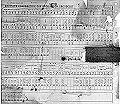

Read Jay McKee's interesting story about his adventure deciphering the build sheet on his 1966 Imperial.

Recently, I reminisced about the day that I discovered the original Chrysler Corporation Broadcast Sheet behind the rear seat back in my 1966 Crown 4-door hardtop. This Broadcast Sheet is a computer printed factory specification of how the car is to be built. The sheet stays with the car as it is being built in the factory. When the car is finished, the build sheet (or a copy) is stuffed into the rear seat back for eternity, or until someone discovers it and removes it. Once discovered, the sheet is either preserved and cherished or tossed out as trash. I had once heard someone call the Chrysler Broadcast Sheet the "birth certificate" of the car. This sheet holds a wealth of information about the car's original equipment and specs if it can be decoded. I myself do not know how to decode or read the build sheet.
I discovered the build sheet one day while working on restoring the rear package tray in our '66 Crown hardtop. At the time I didn't know the first thing about what this document was, but I realized that it must hold some significant historical value about the car, so I preserved it the best I could for future decoding and reference. If your car has the original rear upholstery, chances are good that this document is still there, stuffed into the rear seatback. Below is the story of how I retrieved ours.
The story is more of a rescue/reconstruction operation than simply extracting the sheet and putting it away for safe keeping somewhere. I was working in the trunk one day and as I pulled the cardboard trunk liner down and away from the rear seat back, there appeared to be a piece of paper pinned in between the seat back springs and the seat padding. There appeared to be printing on it but I could not read it because the printing was facing away from me. I tried to pull the paper out, but it was old and very brittle. Everytime I tried to pull on it, I would break a piece of it away. After much fighting with the seat springs, pulling them away from the padding and trying to free the paper without damaging it, I had what I thought was the entire document. I really didn't have "it" out, I really had all the PIECES of it out. I must have had 30+ pieces of paper in sizes ranging from 2" to the size of small insect. All the pieces had varying degrees of water staining, creases! , warpage, and discoloration fro m being pinned in the seat for 30+ years. All the pieces were VERY FRAGILE. Any attempt to flatten the warpage or unfold the creases resulted in them breaking into little tiny pieces. I wanted to learn more about this document (and thus the car), so I definitely had an interest in reconstructing and preserving it. The printing and numbers were still legible, but how was I going to reconstruct it without breaking it into dust particles?
This is what I did...
I took all the pieces, no matter how small, into the house and laid them out on the kitchen table. I started to boil a pot of water. When the water was boiling up a good head of steam, I used tweezers to hold a piece of the build sheet above the pot and steamed the piece of paper for several seconds. The paper would twist and squirm as it absorbed the water vapor. When I felt that the paper had a good steaming, I opened up my copy of Imperial 1964-1968 Photo Archive (and you thought that it was just used for photo reference!), and placed the paper between the pages in order to hold it flat while it dried.
I performed this operation on every single piece of the build sheet that I had, inserting each piece between different pages in the book.
The next day I carefully opened the book and, page by page, I removed the pieces. With the largest piece lying face up, I started to reconstruct the "puzzle." Once I had it all laid out properly, I turned the largest piece over and started to piece the build sheet back together using transparent tape (I reconstructed it from the back so I wouldn't have tape all over the front of the document.) I used tweezers and an X-Acto knife to carefully move the pieces into position before I would commit them to taping. Once I had all the pieces together, I put a few pieces of tape across the front of the document where it consisted of the smaller pieces and where I thought it was still particularly fragile.
The end result was a nearly complete Chrysler Corporation Build Sheet that was perfectly legible. All the data is preserved. I still have the build sheet and plan on keeping it being it's the only historically significant document that is original for this particular car.
Tip from Joe Caruso:
Anyone can decode most of the fender tag and your build sheet by purchasing the source code books by Galen Govier.